Abstract
The present investigation was carried out to study the ameliorative effects of l-Met (l-methionine) on Pb-exposed mice by the measurement of the weight gain, the weight of organs, the Hb content, the level of lipid peroxidation (LPO), and the Pb and Fe contents of selected organs and serum. Thirty mice were randomly divided into the healthy control group (A), the Pb control group (B), and the Pb+l-Met-treated group (C). Lead-induced depression of growth and Hb content was reversed when l-Met was added to the daily drinking water. The level of LPO of all the samples from group B was significantly higher than group A (p<0.05); however, in group C, it was lowered, especially that in the brain, kidney, and serum, which were not significantly different than normal (p>0.05). Significant enhancement of Pb content (p<0.05) and significant decrease of Fe content of all the samples in group B (p<0.05) were observed. However, dietary Met significantly lowered Pb concentration of all the samples (p<0.05) compared to that of the liver and kidney, reaching no significance in comparison to group A (p>0.05). The Fe concentration changed little (p>0.05). The result suggests that l-Met has an ameliorative effect on Pb-exposed mice.
Similar content being viewed by others
References
D. R. Juberg, C. F. Klieman, and C. K. Simona, Position paper of the American Council on science and Health. Pb and Human health, Ecotoxicol. Environ. Safety 38, 162–180 (1997).
R. C. Patra, D. Swarup, and S. K. Dwivedi, Antioxidant effects of α-tocopherol, ascorbic acid and l-methionine on Pb induced oxidative stress to the liver, kidney and brain in rats, Toxicology 162, 81–88 (2001).
M. W. Shannon and J. W. Graef, Pb intoxication in infancy, Pediatrics 89, 87–90 (1992).
G. Lockitch, Perspectives on Pb toxicity, Clin. Biochem. 26, 371–381 (1993).
D. C. Rice, Pb induced changes in learning: evidence for behavioral mechanisms from experimental animals studies, Neurotoxicology 14, 167–178 (1993).
W. L. West, E. M. Knight, C. H. Edwards, et al., Maternal low level Pb and pregnancy outcomes, J. Nutr. 124, 981–986 (1994).
R. A. Goyer, Results of Pb research; prenatal exposure and neurological consequence, Environ. Health Perspect. 104, 1050–1054 (1996).
H. A. Ruff, M. E. Markowitz, P. E. Bijur, et al., Relationship among blood Pb levels, iron deficiency, and cognitive development in two-year-old children, Environ. Health Perspect. 104, 180–185 (1996).
V. N. Adonaylo and P. I. Oteiza, Pb Intoxication: antioxidant defenses and oxidative damage in rat brain, Toxicology 135, 77–85 (1999).
R. Sandhir and K. D. Gill, Effect of Pb on lipid peroxidation in liver of rats, Biol. Trace Element Res. 48, 91–97 (1995).
S. J. Wang, Lead intoxication, in Internal Medicine, 4th ed., H. Z. Chen and Z. M. Li, eds. People’s Medical Publishing, Beijing, pp. 864–867 (1996).
A. A. Mylroie, L. More, and U. Erogbogbo, Influence of dietary factors on blood and tissue lead concentrations and lead toxicity, Toxicol. Appl. Pharmacol. 41, 361–367 (1977).
D. M. Latta and W. E. Donaldson, The lead toxicity in chickens: Interactions with dietary methionine and choline, J. Nutr. 116, 1561–1568 (1986).
M. Boaz, Z. Matas, A. Biro, et al., Comparison of hemostatic factors and serum malondialdehyde as predictive factors for cardiovascular disease in hemodialysis patients, Am. J. Kidney Dis. 34, 438–444 (1999).
P. W. Beatty and D. J. Reed, Involvement of the cystathione pathway in the biosynthesis of glutathione by isolated rat hepatocytes, Arch. Biochem. Biophys. 204, 80–87 (1980).
Y. Q. Lu and T. J. Gu, The metabolism of sulfur-bearing amino acids, in Biochemistry, 4th ed., T. J. Gu and Z. C. Feng, eds., People’s Medical Publishing, Beijing, pp. 217–218 (1995).
S. Cheng and H. Q. Ding, Today’s discussion of GSH and the antioxidation, Prog. Physiol. Sci. 33, 85–90 (2002).
Y. Q. Liu and J. G. Fan, The research development of the cooperative drugs in the Pb expelling, Foreign Med. Sci. 24, 11–19 (1997).
L. J. Lawton and W. E. Donaldson, Pb-induced tissue fatty acid alterations and lipid peroxidation, Biol. Trace Element Res. 28, 83–97 (1991).
H. P. Monteiro, D.S.P. Abdalla, A. S. Arcuri, et al., Oxygen toxicity related to exposure to Pb, Clin. Chem. 31, 1673–1676 (1985).
H. Gurer, H. Ozgunes, R. Neal, D. R. Spitzard, and N. Ercal, Antioxidant effects of N-acetyle cysteine and succimer in red blood cells from Pb exposed rats, Toxicology 128, 181–189 (1998).
R. C. Patra and D. Swarup, Effects of Pb on erythrocytic antitoxidant defense, lipid peroxide level and thiol groups in calves, Res. Vet. Sci. 68, 71–74 (2000).
H. P. Monteiro, D.S.P. Abdalla, A. Alario, et al., Generation of active oxygen species during coupled autooxidation of oxyhemoglobin and ζ amino levulinic acid, Biochem. Biophys. Acta 881, 100–106 (1986).
B. Halliwell, Free radicals, antioxidants, and human disease: curiosity, cause and consequence, Lancet 334, 721–724 (1994).
J. Y. Wang, The biosynthesis of several important derivatives of amino acids, in Biochemistry, 2nd ed., T. Shen and J. Y. Wang, eds., Higher Education Press, Beijing, p. 283 (1991).
R. L. Livine, B. S. Berlett, J. Moskovitz, et al., Methionine residues may protect proteins from critical oxidative damage, Mech. Ageing Dev. 107, 323–332 (1999).
Author information
Authors and Affiliations
Rights and permissions
About this article
Cite this article
Xie, L., Gao, Q. & Xu, H. Ameliorative effect of l-methionine on Pb-exposed mice. Biol Trace Elem Res 93, 227–236 (2003). https://doi.org/10.1385/BTER:93:1-3:227
Received:
Accepted:
Issue Date:
DOI: https://doi.org/10.1385/BTER:93:1-3:227




